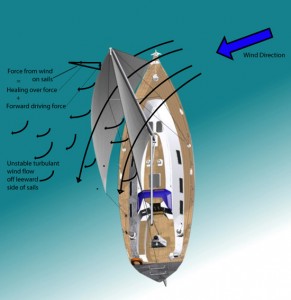Reef un reef reef unreef
When you’re racing you need to get the most out of your rig and that’s exactly what we had to do in the Austin Yacht Club Red Eye January 1st Race event. While one weather channel was predicting 6-8 knots another was saying 15-20. In the last sailing blog I’d mentioned that we were going light wind sailing – not true. Biggest gust was to 25 knots and mostly the wind was around 17 knots. That’s reefing time. Ahh that’s for the weak at heart might say some – but reefing increases your performance.
Reefing reduces the size of the sail. When reefing a roller furling sail the sail is rolled up a little. The first reefing point for a roller furler is about 15%. Thus is the foot of your sail is 12 ft long then roll the sail up about 18 inches.
They way that the sails performance is increased is it helps the wind stay attached to the lee side of the sail. Slow moving air can bend around the curve of the sail and stay attached. Fast moving air has more momentum and can not stay attached. Thus it swirls off creating turbulence in its wake which vastly upsets the balance of low pressure on the lee side of the sail and high pressure on the windward side. The art of sailing is all about the even flow of wind over the sail and allowing this turbulence to happen is one way to loose a race.
The image below is taken from Module 7 of the Skipper course and from the Sail Trim Course. It shows wind swirling inefficiently off the sails.
The other part to reefing is that the height of the center of force acting on the sail is reduced. This reduces the heeling force. IE the boat tips over less. Most boat hulls operate with the least amount of drag either flat or slightly tilted. Tilting over too far will increase the hull drag in the water. With high winds and an unreefed rig, you’re certainly going to be tipped over beyond the most efficient point.
So reef that sail.
Downwind is a slightly different story. As long as it is safe – ie the winds aren’t too high – you can let the reef out to capture more wind against the sail area. Remember the apparent wind against the sail going downwind is reduced because your speed subtracts from the true wind speed when going down wind. However you have to be a wee bit cautious with this. At one point we needed to steer up wind a little to miss a shoal, a gust came through at the exact same time and also a boat flying a spinnaker came past us. Our boat began to round up into the wind but also into the other boat. To save the day we let all the sails fly so that the rudder could overpower any turning effect the sails had against us. This allowed us to turn back down wind with out loosing much of our speed or heading.
About 2 hundred yards short of the mark on the down wind leg I had the crew re-reef the main sail so that we were prepared to come back up onto a close haul for the next upwind leg. Always make sure you do this is plenty of time. Being 50 yards early is better than being past the mark and still messing with the reefing where you’ll loose valuable time.
We had two downwind legs and 3 upwind legs so we had to reef – unreef – reef – unreef – then reef again. Good practise for the crew and the barking captain – right? Wrong Captains never bark!
In our sailboat race on new years day, we elected to reef the main sail about 25% (2 reefing points) to reduce the rounding up effect. See last blog on rounding up. But we left the head sail fully out. The reason for not reefing the head sail was because a reefed roller furling head sail never really behaves efficiently due to the disturbance on the sail created by a bunched luff. IE the rolled sail on the leading edge doesn’t allow for smooth wind flow over the sail. Also the sail shape is always not quite how you want it. Even tho you move the cars forward, the shape is never how you’d want it. But if the wind conditions had gotten any worse then we’d be forced to reef the head sail as well.
Admittedly we didn’t do too well in the race but at least we all did our best and had a great start to the new year.
- RYA Day Skipper with NauticEd - April 1, 2024
- NauticEd uses the SailTies GPS Tracking App - March 29, 2024
- Sea of Cortez Flotilla – February 2025 - March 8, 2024




